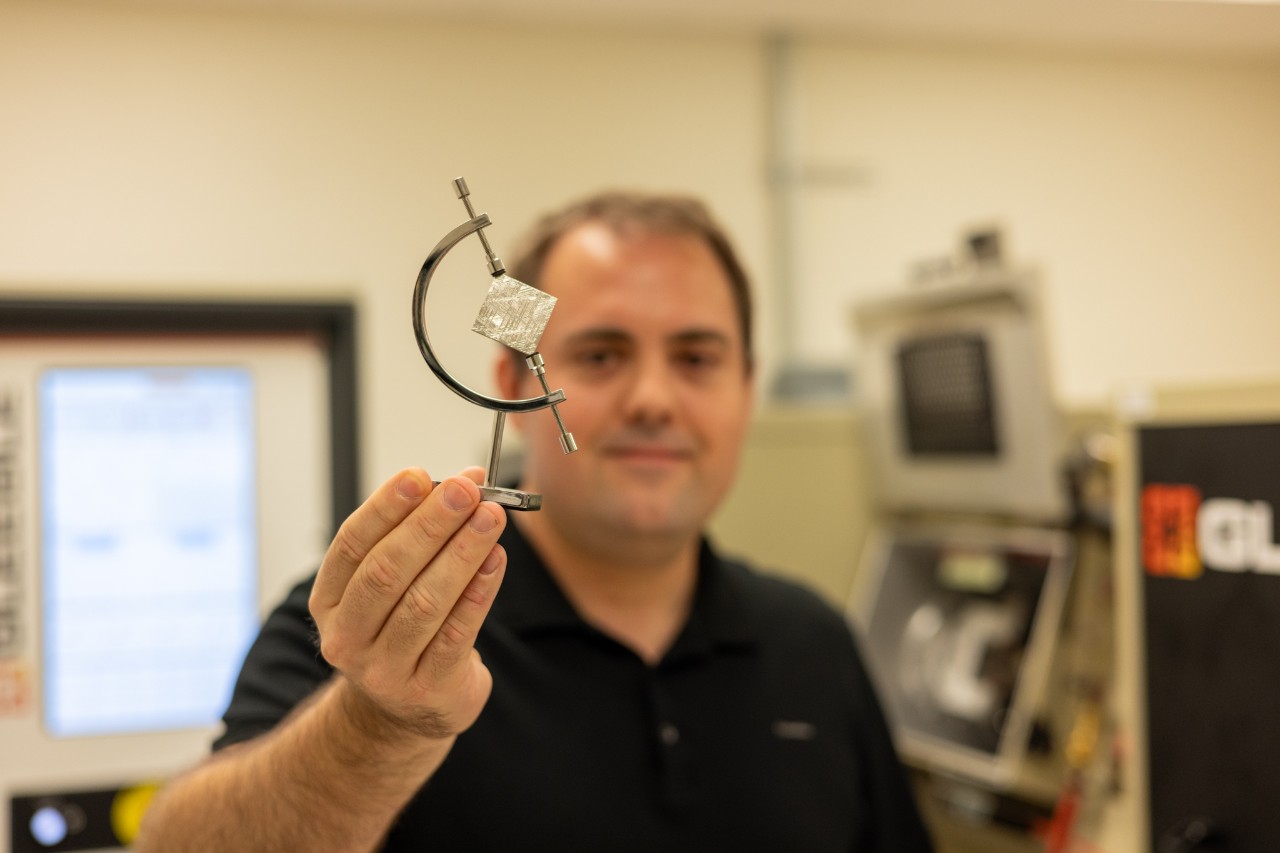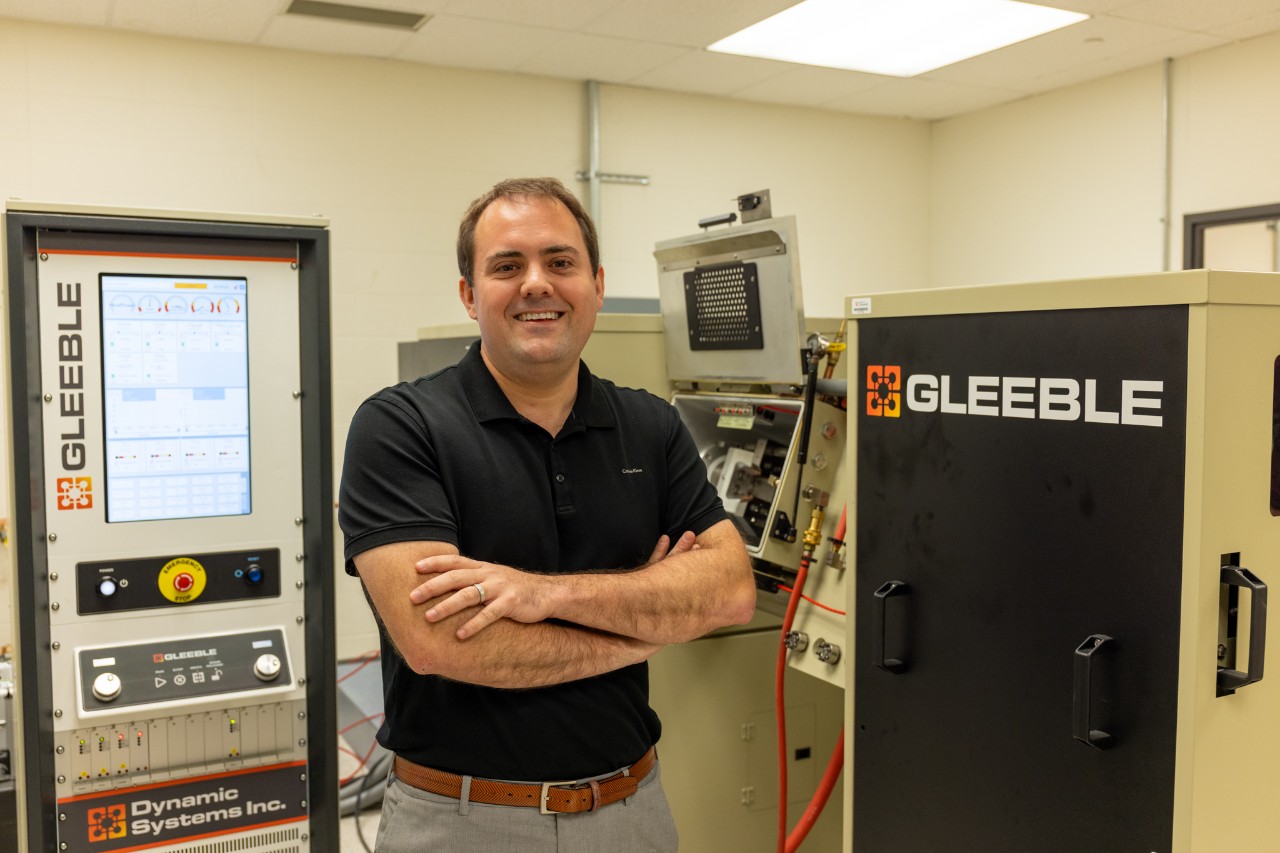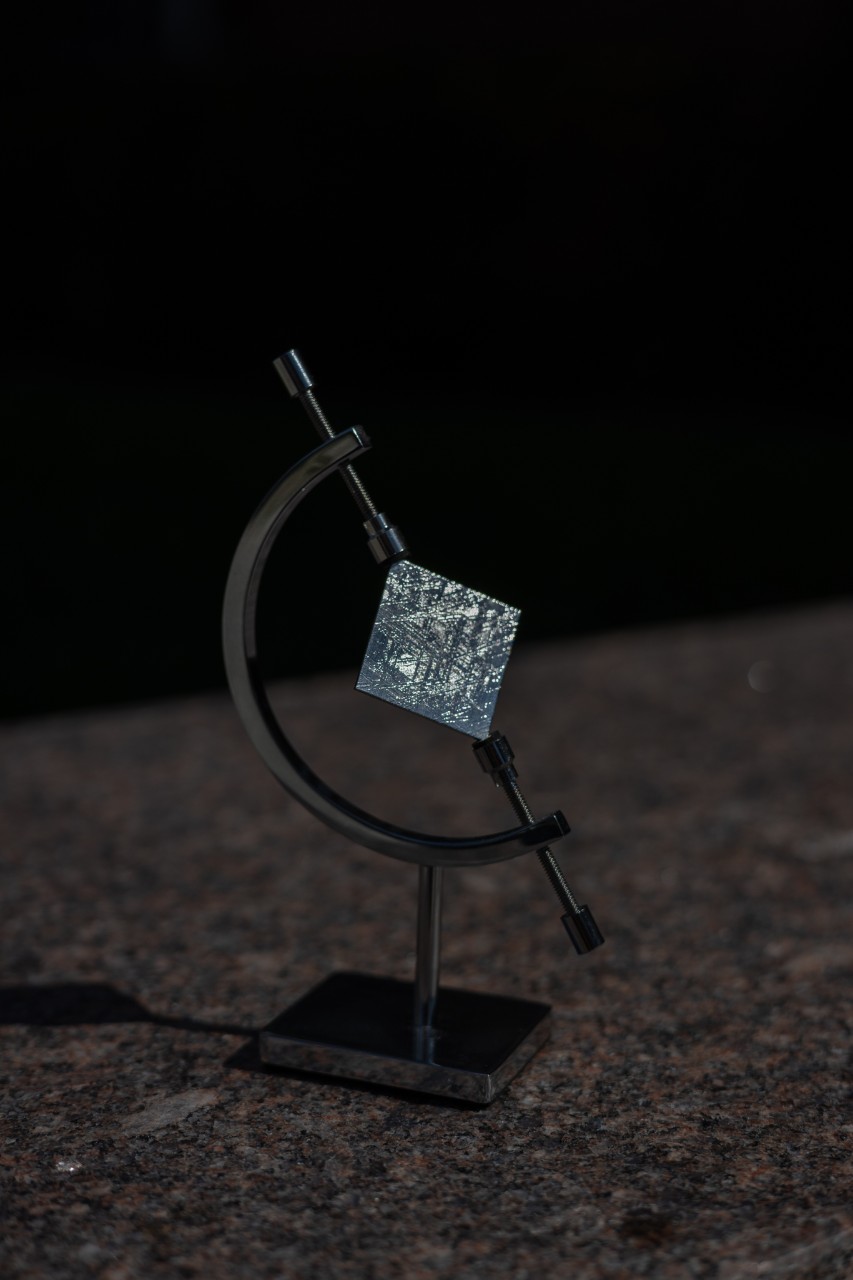
UC engineer explores better materials for clean energy solutions
Metals physicist awarded DoE Early Career grant to develop sustainable magnets for electric vehicles
As the world embraces sustainable transportation and clean energy, researchers at the University of Cincinnati are trying to solve the challenges of these growing technologies. Innovations like electric vehicles and wind turbines rely on high-strength permanent magnets to operate, but the scarcity of rare-earth elements in these magnets poses a significant obstacle.
Matt Steiner, assistant professor of materials science and engineering at UC’s College of Engineering and Applied Science (CEAS), is working to solve a piece of the puzzle that could lead to the development of more accessible alternative magnets.

Matt Steiner in his lab. Photo/Corrie Mayer/CEAS Marketing
“In materials science, we are always thinking about supply-limited materials,” Steiner said. “For example, in car batteries, lithium and cobalt are very supply limited. It’s one of the reasons why electrifying things has been such a challenge, because these low supply materials put a strain on the whole system.”
Steiner’s lab is focusing on the science behind the creation of a special type of iron-nickel magnet, called tetrataenite. Tetrataenite is the perfect replacement for the rare-earth magnets currently used in EVs and wind turbines because the materials are relatively abundant and have the necessary magnetic properties. However, it takes the atoms in iron-nickel millions of years to properly diffuse and become the ideal magnet. Steiner and his team are testing strategies to drastically accelerate this process in the lab to create this super-strong magnet in bulk for use in clean energy technologies.

A piece of a meteorite containing tetrataenite. Photo/Corrie Mayer/CEAS Marketing
When iron and nickel are melted and cast, the atoms start out in a jumble but eventually end up in what Steiner calls a “layer cake structure,” with a layer of iron alternating with a layer of nickel, and so on, which is the configuration required to rival the rare-earth magnets currently in use.
“The atoms are eventually going to order themselves the way we want, but we are exploring methods to encourage them to get there faster,” Steiner said. “So instead of millions of years, we can try and encourage it to happen in weeks or days.”
Scientists first discovered this tetrataenite layer-cake structure in meteorites over 50 years ago — Steiner keeps one in his lab for inspiration — and researchers have been trying to replicate its properties on Earth ever since.
Steiner received the prestigious Department of Energy Early Career Research Award in 2023, granting him $875,000 to continue this research project over the next five years.
While earning his bachelor’s in applied physics from Columbia University and his PhD from the University of Virginia in Charlottesville, Steiner developed an affinity for science that had more direct applications rather than more mathematical ones. During his undergraduate years, Steiner discovered an interest in physics, specifically nuclear and plasma physics, which set him on the trajectory leading him to where he is today. Now, through this DoE research grant, he hopes to share that inspiration and drive for direct scientific application with the next generation of students.
“This grant provides me the luxury to be able to sit down for five years with a PhD student to really focus on the work that we do, and it provides our students with opportunities that they otherwise may not have had before,” Steiner said.
In addition to his iron-nickel magnet research, Steiner is the primary adviser to four graduate students and has three undergraduate students that work in his lab. Recently, Steiner also completed research projects evaluating steel corrosion in bridges, sensitization of marine aluminum alloys, developing new nickel-based alloys for high temperature applications and analyzing uranium nuclear fuel alloys. He graduated his first PhD student this October.
“I’m hoping, if nothing else, that all of the work I do with my students establishes that materials science is a growing interdisciplinary field that is vital to our collective success in the world of science. A lot of people look at things like metallurgy as sort of dead fields, when they’re really not,” Steiner said.
Steiner is also honored to be a vital part of putting UC onto bigger stages in the research world. Steiner, along with Annette Rowe from biological sciences, was one of two professors from UC who received the Department of Energy grant this year. The Department of Energy only gives around 50 of these grants to university researchers every year, making Steiner’s award particularly noteworthy.
“As materials scientists, we are constantly researching and producing parts and materials that are vital to everything we need, from driving to manufacturing to flying. Our graduates have a high job placement rate because there are so many exciting and diverse applications for materials science that most people just aren’t exposed to at the college level. It’s important for people to know how important the work that we do is. I’m excited to keep pushing our knowledge further alongside my students over the next five years.”
Featured image at top: In his lab, Matt Steiner, assistant professor of materials science and engineering, holds an inspirational meteorite piece. Photo/Corrie Mayer/CEAS Marketing
Learn more about CEAS
Discover the research and academic advantages at the College of Engineering and Applied Science.
Related Stories
UC Day of Giving kicks off with celebration of scholarship gift
April 15, 2021
UC Day of Giving is kicked off with an important scholarship gift for nursing and engineering.
Village Life partners with UC International to support Global Scholars
April 14, 2021
Two students from Tanzania receive Global Opportunity Scholarships and get a big Bearcat welcome!
UC’s summer semester offers students short sessions, flexibility
April 12, 2021
Coming into the summertime of 2020, Sumedha Kappagantula was considering ways to make the most her opportunities during what is usually a break from the academic rigor of her traditional school year. As a Biomedical Engineering major in the UC’s College of Engineering and Applied Sciences, Kappagantula is minoring in Chemistry and Biological Sciences, taking classes through the College of Arts and Sciences. She thought summer semester would be a great time to get ahead in her coursework, and move her degree forward.
Neil Armstrong UC Forward Innovation Award 2021 winners announced
April 13, 2021
Team of three undergraduate students from different disciplines excel in an innovation course at the University of Cincinnati.
UC engineering students recognized for achievement in cooperative education
April 12, 2021
Top students in engineering cooperative education for 2020-21
UC garners sustainable, green campus success
April 19, 2021
University of Cincinnati Gold LEED certifications, student-involved energy-efficient programs and climate-friendly green technologies elevate UC to a national award-winning sustainable campus.
Futuristic cars may soon take flight
April 28, 2021
The Cincinnati Innovation District and University of Cincinnati team up with partners in 1819 Innovation Hub DriveOhio, Cincinnati Bell and Microsoft to innovate with UC talent and help bring future innovation within reach in FlyOhio student challenge.
UC Day of Giving a success
April 28, 2021
University of Cincinnati Day of Giving’s 24-hour challenge was a tremendous success this year, raising $2,219,197 with 3,232 gifts. The fourth annual UC Day of Giving raised its most money to date with alumni, donors, students, faculty and staff joining together to support UC and UC Health.
'To make him proud was high on her list'
April 1, 2021
Alex Lewis lost her 82-year-old grandfather to Covid-19 just five weeks before her dream school showed up on the front steps of Roger Bacon High School to tell the senior that she has been admitted to the University of Cincinnati College of Nursing as part of a touching Decision Day surprise effort this year.
From Singapore to Cincinnati: UC guides grad to success
June 4, 2021
UC grad talks about how her time in UC's College of Arts and Sciences set her up for success.
